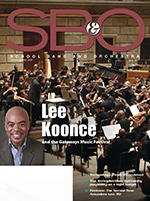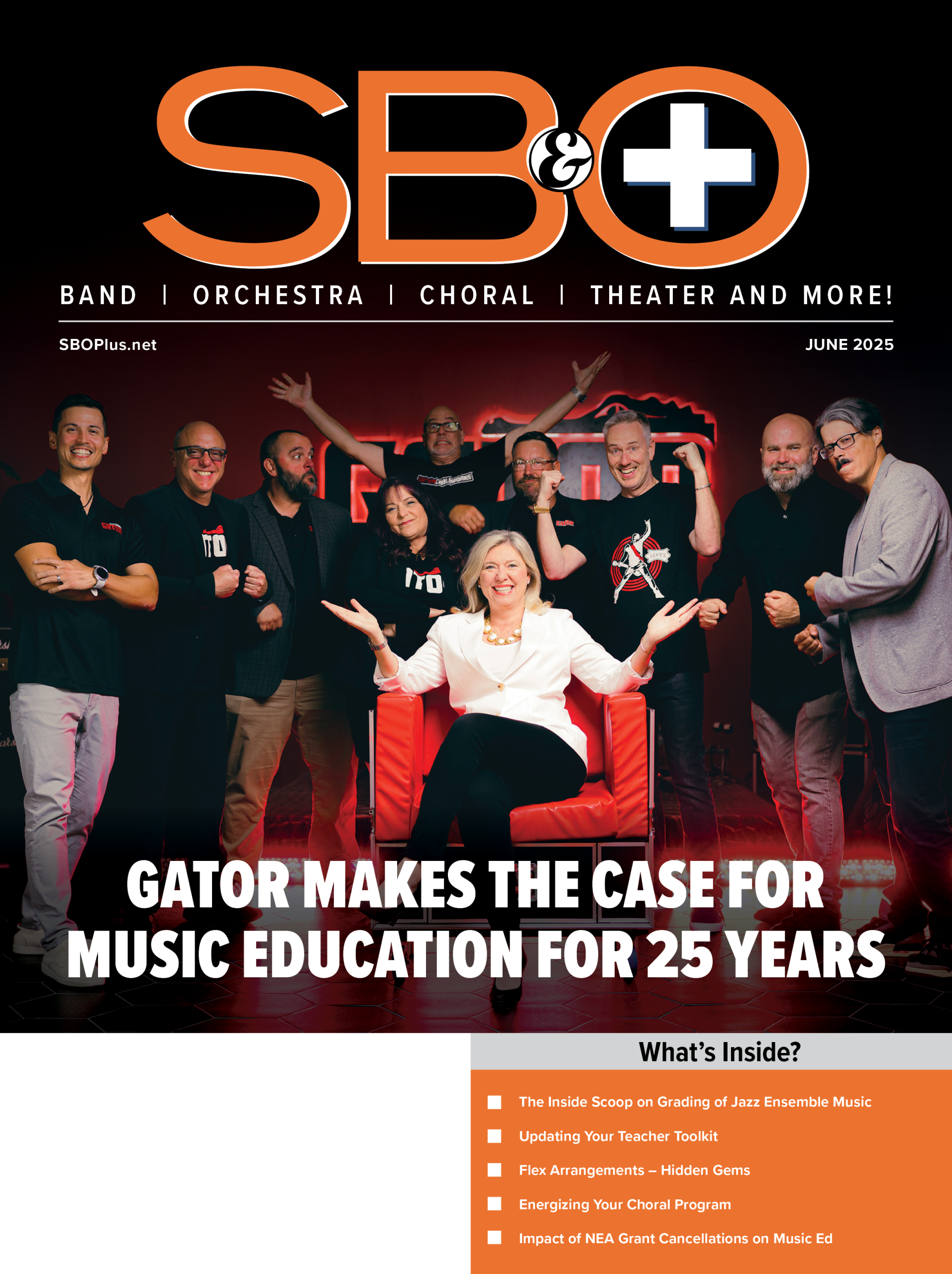Unity. Without it, your music group would fall apart during performances. The clarinets would play two beats behind the trumpets. The flutes would play in a different key. And the tubas would be working on the theme to Star Wars while the rest of the class plays Mozart.
But did you know that unity among the music educators in your district is equally important to the success of your program?
“When you see one director, most of the time, you see all of us,” said Cathy Fishburn, orchestra director at Doerre Intermediate School in the Klein Independent School District in Texas.
Klein ISD is made up of seven intermediate schools and four high schools. Orchestra begins in fifth grade as an elective. The high school orchestra boasts 110 students – more than 400 percent growth over the past 15 years – and all of the orchestras in the district enjoy support from the administrators and the parents. Fishburn said it’s because the directors work together in a variety of ways.
For instance, they make it a point to attend each other’s concerts, helping to tune the kids or simply getting to know them, by joking and chatting, while they’re waiting to go onstage.
“We always introduce each other at our concerts,” said Keith Markuson, Fishburn’s colleague at Klein High School. “It has to be a partnership all along. That’s been the hallmark of what we do here. Having ownership of the program and helping the kids to feel like, ‘He’s going to be my director some day, and he’s here right now [supporting us].'”
A concert also provides a prime opportunity for the directors to present their united front to school principals and to parents. The district’s administrators understand that there’s a bond among members of the music department. This makes it easier for the department to obtain funding or to make requests; administrators know they won’t be facing just one director, but all of them.
The Importance of Reaching Out
In addition to attending concerts, directors in Klein ISD visit with – and help teach – the younger students at least twice a week.
“Even though parts of four elementary schools feed into my school particularly, I only teach at two schools. So I try to get over to the other two [elementary] schools whenever I can,” Fishburn said. “But the high school director sees them, too.” This builds a connection across the spectrum, from grades five through 12.
The high school teachers also visit with the intermediate school feeder groups. Markuson said, “Four days a week, my assistant and I go out and spend two days each at both of the schools. We do it in different combinations. Some days we’ll both go; some days I’ll be the only one. We do sectionals, or we’ll take ensembles and help them with music. Occasionally, we’ll just stand and make comments to the group as they’re playing, but most of the time we’re teaching kids.”
Given the many demands on a music director’s time, it’s not always easy to travel from campus to campus. However, the teachers in Klein have made it a priority, and have imparted the importance of this approach to their principals. “We’ve arranged our schedules – and we’re very determined to keep our schedules – in such a way that we have that time available,” Markuson said.
Team Teaching
Hays Independent School District in Buda, Texas, has a more formal arrangement to ensure that high school directors reach out to their feeder programs. The music department employs a “team teaching” program, which Hays High School band director Tony Gibbs said is “not typical in a school this size.”
Hays ISD has three middle schools and one high school. There are 12 band directors throughout the district. Band begins in sixth grade, at the middle school.
Gibbs explained the team teaching methodology. “High school band directors are on middle school campuses every day, and the middle school directors are on the high school campus every day, [usually] helping with the marching band.”
Hays High School, a 5A classification, the largest in Texas, has a wind ensemble and three symphonic bands, as well as a marching band comprised of all 300 students in the program.
At the middle schools, the high school directors assist in band rehearsals and also teach sectionals for beginning players.
“They’ll teach the specific instrument that is their specialty,” Gibbs said. “We have a double reed guy, trombone player, flute players, clarinet, et cetera.”
The band program retains approximately 65 percent of the students from the middle school to the high school.
“I think the middle school kids are a lot more comfortable staying in band when they transfer from one school to the next than they are in places where the directors are totally separate.”
‘The Music Director’s Not an Ogre!’
Many high school band and orchestra directors have full schedules and limited resources, which may make it impossible for them to teach the younger grades on a regular basis. Additionally, some administrators may not support team teaching. What can a director do to reach out to the students – and directors – at the lower levels?
“The first thing to do,” Markuson said, “is build a bridge with the junior high school director. High school directors, lots of times, don’t feel like they have the time or the resources to go and talk to the kids and answer their questions, reassure them. At the very least, that’s what they need to do.”
Gibbs agreed. “The thing to do is go to those campuses on occasion, so the kids can see you. Let them see that the high school director is not some big bad ogre.”
Gibbs advised high school directors to encourage younger students, assure them that they’re good enough to perform with the band, and that it’s not as intimidating as it seems.
Markuson said directors can make the process of stepping up less intimidating by making a personal connection with the students. He recalled his experience auditioning a junior high student years ago.
“She played about three notes and she broke down and cried the whole time. She was totally undone by the whole experience. I looked at her and said, ‘Don’t worry about it. You can be in the orchestra. We’re thrilled to have you.’ As a senior, she ended up as president of the orchestra. But [at the time] she was so nervous and upset, she was ready to quit right there.”
His own band experience as a junior high graduate entering the high school band was only slightly less harrowing. “I got a packet with pieces of music in it that said, ‘Have this memorized and we’ll see you in the fall.’ I was scared. I came close to not signing up,” he recalled.
Today, at Klein ISD, the team of directors is there to answer students’ questions. “They want to know how rehearsals are structured, how sectionals work. They’re curious about the uniforms. They’re curious about the whole structure,” Markuson said.
Being ready with answers to questions also prepares parents for what they should expect with a child in the high school music program.
Gibbs, at Hays High School, holds a meeting with incoming freshmen and their parents to answer their questions, particularly about marching band. He also sends out an information packet with answers to parents’ most frequently asked questions, as well as a band rehearsal schedule. Gibbs uses the high school band Web page, as well, to communicate with parents throughout the year.
Connecting in a Social Setting
Social events can help students get comfortable with their future directors in an informal setting.
Fishburn said that Klein’s social events, including a Fall Harvest Party held right before school begins in September, encourages students to stay in orchestra when they move from the elementary to the intermediate school.
“They know my face. They know they’re going to have a home immediately when they come over here,” she said.
These fun events also offer a “value-added” benefit to kids who join orchestra. “They’re aware that they’re doing things that the other kids in their school are not,” Fishburn said. “They’re coming over to the junior high and high school for concerts, meetings, events. They’re starting to be the ‘big kids.’ They feel more important than anyone else in their school.”
Markuson added, “It humanizes us to them a little bit. The more they get to know us as individuals, and we’re able to joke around with them a little bit, the more they can see what it’s going to be like when they get to high school.”
Joint Concerts
Combined concerts – when middle school and high school students perform together – let directors with limited time reach out, simultaneously, to parents and students. Both Klein and Hays hold such events.
At the beginning of the school year, Klein ISD rents a concert hall and holds a performance featuring the high school and both of the feeder junior highs. Each group plays individually – the junior high non-varsity orchestra, the junior high varsity orchestra, and the high school groups – and then the junior high orchestras perform together.
“The idea being that these are the kids who are going to come together in high school,” Markuson said. “It drives home the point to the parents that there’s a logical progression. It’s a continuum, a curriculum that’s linear.”
Hays High School calls its concert event the “Band-o-Rama,” and features the middle school groups and the high school band.
“It’s over 1,000 kids out on the field – high school and middle school all at once,” Gibbs said. “We play a song all together, and it sounds like the devil because it’s so spread out, but the moms and dads just love it. It makes quite an impression to the parents that their kid is going to be in this all the way through.”
However, he said that making some connection with the elementary and middle school students, “to go and talk to them and answer their questions and reassure them,” is the bare minimum of what can be done to improve retention. “The first thing you have to do is build a bridge with your junior high school director,” he said.
Dawn Schloesser is a New York-based freelance journalist who specializes in the music and audio/video industries. As the former editor of the former publication Band & Orchestra Product News, she has been covering school instrumental music programs for more than seven years. Last year, she edited “The Creative Band and Orchestra,” by Julie Lyonn Lieberman. She is currently the associate editor of Claws in Creativity, an e-zine that focuses on all facets of creativity, including art, writing, music-making and composition.


























